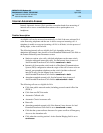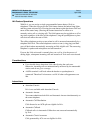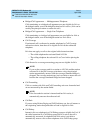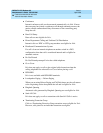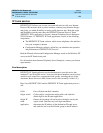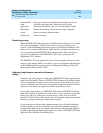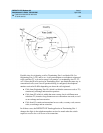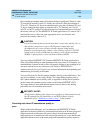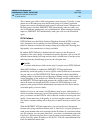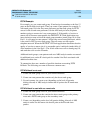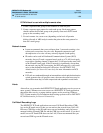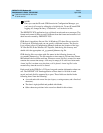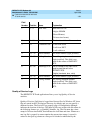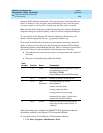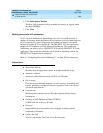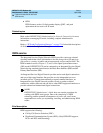
DEFINITY ECS Release 8.2
Administrator’s Guide
555-233-506
Issue 1
April 2000
Features and technical reference
1387IP trunk service
20
This is where your AAR or ARS route pattern comes into play. Typically, a route
pattern for an IP trunk group uses the IP trunk group as its primary route and
assigns one or more conventional trunk groups as alternate routes. Whenever the
IP trunk group is blocked, DEFINITY ECS automatically routes its traffic over
one of the alternate trunk groups you’ve administered. When transmission quality
improves, DEFINITY ECS automatically sends your calls over the IP network
again.
PSTN Fallback
PSTN Fallback uses the Public Switched Telephone Network (PSTN) to reroute
calls. It monitors service quality over each IP trunk group, allowing you the
benefit of Internet or intranet call savings whenever possible while ensuring that
high quality voice transmission is always available.
By default, PSTN Fallback is disabled and calls route over the IP network
regardless of the voice quality. If transmission quality degrades, calls over the IP
network timeout during call setup and users hear a reorder tone (a fast busy tone)
indicating that they should hang up and try the call again later.
NOTE:
Continue with the rest of this section only if you plan to use PSTN Fallback.
When PSTN Fallback is enabled, the DEFINITY IP Trunk application
periodically checks the quality of service (QOS) on the IP network, to the remote
site you want to call. The DEFINITY IP Trunk application checks the QOS by
sending packets to the remote site and keeping a running average of the results of
several samplings of the packets sent. When the averages exceed specified limits,
the DEFINITY IP Trunk application instructs the switch to route calls to the
remote IP trunk site through the PSTN. In order for PSTN Fallback to work
properly, trunk groups must be administered consistent with Line Pools and the
associated quality of service limits.
Quality of service to one remote site (IP address) may be poor while quality of
service to another remote site is good. If the quality of service to one remote site is
poor, you want to use the PSTN for calls to that site in order to ensure good voice
quality. At the same time, if the quality of service to another remote site is good,
you want to continue sending calls to that site over the IP network in order to save
costs.
With the DEFINITY IP Trunk application, you use Line Pools to distinguish
between calls going to different remote sites. A Line Pool is a logical grouping of
trunk group members that are associated with the IP address of a particular remote
site. For example, you can create Line Pool 1, associate a certain trunk group with
Line Pool 1, and associate Line Pool 1 (and its trunk group members) with a site
in New York City whose IP address is 192.68.25.1. You can create additional Line
Pools for additional remote sites.



